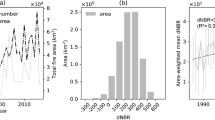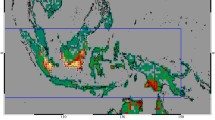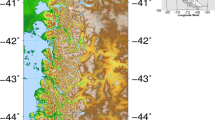Abstract
Boreal fires can cool the climate; however, this conclusion came from individual fires and may not represent the whole story. We hypothesize that the climatic impact of boreal fires depends on local landscape heterogeneity such as burn severity, prefire vegetation type, and soil properties. To test this hypothesis, spatially explicit emission of greenhouse gases (GHGs) and aerosols and their resulting radiative forcing are required as an important and necessary component towards a full assessment. In this study, we integrated remote sensing (Landsat and MODIS) and models (carbon consumption model, emission factors model, and radiative forcing model) to calculate the carbon consumption, GHGs and aerosol emissions, and their radiative forcing of 2001–2010 fires at 30 m resolution in the Yukon River Basin of Alaska. Total carbon consumption showed significant spatial variation, with a mean of 2,615 g C m−2 and a standard deviation of 2,589 g C m−2. The carbon consumption led to different amounts of GHGs and aerosol emissions, ranging from 593.26 Tg (CO2) to 0.16 Tg (N2O). When converted to equivalent CO2 based on global warming potential metric, the maximum 20 years equivalent CO2 was black carbon (713.77 Tg), and the lowest 20 years equivalent CO2 was organic carbon (−583.13 Tg). The resulting radiative forcing also showed significant spatial variation: CO2, CH4, and N2O can cause a 20-year mean radiative forcing of 7.41 W m−2 with a standard deviation of 2.87 W m−2. This emission forcing heterogeneity indicates that different boreal fires have different climatic impacts. When considering the spatial variation of other forcings, such as surface shortwave forcing, we may conclude that some boreal fires, especially boreal deciduous fires, can warm the climate.




Similar content being viewed by others
References
Akagi SK, Yokelson RJ, Wiedinmyer C, Alvarado MJ, Reid JS, Karl T, Crounse JD, Wennberg PO (2011) Emission factors for open and domestic biomass burning for use in atmospheric models. Atmos Chem Phys 11(9):4039–4072
Amiro BD et al (2006) Carbon, energy and water fluxes at mature and disturbed forest sites, Saskatchewan, Canada. Agric For Meteorol 136(3–4):237–251
Amiro BD, Cantin A, Flannigan MD, de Groot WJ (2009) Future emissions from Canadian boreal forest fires. Can J For Res 39(2):383–395
Andreae MO, Merlet P (2001) Emission of trace gases and aerosols from biomass burning. Glob Biogeochem Cycles 15(4):955–966
Beck PSA, Goetz SJ, Mack MC, Alexander HD, Jin YF, Randerson JT, Loranty MM (2011) The impacts and implications of an intensifying fire regime on Alaskan boreal forest composition and albedo. Glob Chang Biol 17(9):2853–2866
Bertschi I, Yokelson RJ, Ward DE, Babbitt RE, Susott RA, Goode JG, Hao WM (2003) Trace gas and particle emissions from fires in large diameter and belowground biomass fuels. J Geophys Res-Atmos 108(D13):8472
Bond TC, Zarzycki C, Flanner MG, Koch DM (2011) Quantifying immediate radiative forcing by black carbon and organic matter with the specific forcing pulse. Atmos Chem Phys 11(4):1505–1525
Bond TC et al (2013) Bounding the role of black carbon in the climate system: a scientific assessment. J Geophys Res-Atmos 118(11):5380–5552
Collins WJ, Fry MM, Yu H, Fuglestvedt JS, Shindell DT, West JJ (2013) Global and regional temperature-change potentials for near-term climate forcers. Atmos Chem Phys 13(5):2471–2485
de Groot WJ, Pritchard JM, Lynham TJ (2009) Forest floor fuel consumption and carbon emissions in Canadian boreal forest fires. Can J For Res 39(2):367–382
French NHF, Goovaerts P, Kasischke ES (2004) Uncertainty in estimating carbon emissions from boreal forest fires, J Geophys Res-Atmos, 109(D14)
Fry MM et al. (2012) The influence of ozone precursor emissions from four world regions on tropospheric composition and radiative climate forcing. J Geophys Res-Atmos 117. doi:10.1029/2011JD017134
Goode JG, Yokelson RJ, Ward DE, Susott RA, Babbitt RE, Davies MA, Hao WM (2000) Measurements of excess O-3, CO2, CO, CH4, C2H4, C2H2, HCN, NO, NH3, HCOOH, CH3COOH, HCHO, and CH3OH in 1997 Alaskan biomass burning plumes by airborne Fourier transform infrared spectroscopy (AFTIR). J Geophys Res-Atmos 105(D17):22147–22166
Gower ST, Krankina O, Olson RJ, Apps M, Linder S, Wang C (2001) Net primary production and carbon allocation patterns of boreal forest ecosystems. Ecol Appl 11(5):1395–1411
Homer C, Huang CQ, Yang LM, Wylie B, Coan M (2004) Development of a 2001 national land-cover database for the United States. Photogramm Eng Remote Sens 70(7):829–840
Huang S, Jin S, Dahal D, Chen X, Young C, Liu H, Liu S (2013a) Reconstructing satellite images to quantify spatially explicit land surface change caused by fires and succession: a demonstration in the Yukon River Basin of interior Alaska. ISPRS J Photogramm Remote Sens 79:94–105
Huang S, Liu H, Dahal D, Jin S, Welp LR, Liu J, Liu S (2013b) Modeling spatially explicit fire impact on gross primary production in interior Alaska using satellite images coupled with eddy covariance. Remote Sens Environ 135:178–188
Huang S, Dahal D, Liu H, Jin S, Young C, Li S, Liu S (2014) Spatiotemporal variation of surface shortwave forcing from fire-induced albedo change in interior Alaska. Can J For Res. doi:10.1139/cjfr-2014-0309
IPCC (2007) Climate change 2007. In: Solomon S, Qin D, Manning M, Chen Z, Marquis M, Averyt KB, Miller MTBS (eds) The physical science basis contribution of working group I to the fourth assessment report of the intergovernmental panel on climate change. Cambridge University Press, Cambridge, p 996
IPCC (2013) Climate change 2013. In: Stocker TF, Qin D, Plattner G-K, Tignor M, Allen SK, Boschung J, Nauels A, Xia Y, Bex V, Midgley PM (eds) The physical science basis. Contribution of working group I to the fifth assessment report of the intergovernmental panel on climate change. Cambridge University Press, Cambridge, p 1535
Ji L, Wylie BK, Nossov DR, Peterson B, Waldrop MP, McFarland JW, Rover J, Hollingsworth TN (2012) Estimating aboveground biomass in interior Alaska with Landsat data and field measurements. Int J Appl Earth Obs GeoInformation 18:451–461
Jin Y, Randerson JT, Goulden ML, Goetz SJ (2012) Post-fire changes in net shortwave radiation along a latitudinal gradient in boreal North America. Geophys Res Lett 39(13), L13403
Joos F, Prentice IC, Sitch S, Meyer R, Hooss G, Plattner GK, Gerber S, Hasselmann K (2001) Global warming feedbacks on terrestrial carbon uptake under the Intergovernmental Panel on Climate Change (IPCC) emission scenarios. Glob Biogeochem Cycles 15(4):891–907
Kasischke ES, Hoy EE (2012) Controls on carbon consumption during Alaskan wildland fires. Glob Chang Biol 18(2):685–699
Kasischke ES, Hyer EJ, Novelli PC, Bruhwiler LP, French NHF, Sukhinin AI, Hewson JH, Stocks BJ (2005) Influences of boreal fire emissions on Northern Hemisphere atmospheric carbon and carbon monoxide. Global Biogeochem Cycles 19(1): GB1012
Kasischke ES, Amiro BD, Barger NN, French NHF, Goetz SJ, Grosse G, Harmon ME, Hicke JA, Liu SG, Masek JG (2013) Impacts of disturbance on the terrestrial carbon budget of North America. J Geophys Res Biogeosci 118(1):303–316
Keeling CD, Whorf TP, Wahlen M, Vanderplicht J (1995) Interannual extremes in the rate of rise of atmospheric carbon-dioxide since 1980. Nature 375(6533):666–670
King AW, Dilling L, Zimmerman GP, Fairman DM, Houghton RA, Marland G, Rose AZ, Wilbanks TJ (2007) The First State of the Carbon Cycle Report (SOCCR): the North American Carbon Budget and Implications for the Global Carbon Cycle, edited by N O a A Administration, Asheville, NC
Liu, H, Randerson JT (2008) Interannual variability of surface energy exchange depends on stand age in a boreal forest fire chronosequence, J Geophys Res, 113, G01006, doi:10.1029/2007JG000483, 2008
Liu HP, Randerson JT, Lindfors J, Chapin FS (2005) Changes in the surface energy budget after fire in boreal ecosystems of interior Alaska: an annual perspective. J Geophys Res-Atmos, 110(D13)
Liu S et al. (2011) Simulating the impacts of disturbances on forest carbon cycling in North America: processes, data, models, and challenges. J Geophys Res-Biogeo, 116
Loehman RA, Reinhardt E, Riley KL (2013) Wildland fire emissions, carbon, and climate: Seeing the forest and the trees—a cross-scale assessment of wildfire and carbon dynamics in fire-prone, forested ecosystems. Forest Ecol Manag 317: 9–19
Lyons EA, Jin YF, Randerson JT (2008) Changes in surface albedo after fire in boreal forest ecosystems of interior Alaska assessed using MODIS satellite observations. J Geophys Res Biogeosci 113(G2), G02012
Meigs GW, Donato DC, Campbell JL, Martin JG, Law BE (2009) Forest fire impacts on carbon uptake, storage, and emission: the role of burn severity in the Eastern Cascades, Oregon. Ecosystems 12(8):1246–1267
Myhre G, Highwood EJ, Shine KP, Stordal F (1998) New estimates of radiative forcing due to well mixed greenhouse gases. Geophys Res Lett 25(14):2715–2718
Nance JD, Hobbs PV, Radke LF (1993) Airborne measurements of gases and particles from an Alaskan wildfire. J Geophys Res-Atmos 98(D8):14873–14882
O’Halloran TL et al (2012) Radiative forcing of natural forest disturbances. Glob Chang Biol 18(2):555–565
Ohse B, Huettmann F, Ickert-Bond SM, Juday GP (2009) Modeling the distribution of white spruce (Picea glauca) for Alaska with high accuracy: an open access role-model for predicting tree species in last remaining wilderness areas. Polar Biol 32(12):1717–1729
Pfister G, Hess PG, Emmons LK, Lamarque JF, Wiedinmyer C, Edwards DP, Petron G, Gille JC, Sachse GW (2005) Quantifying CO emissions from the 2004 Alaskan wildfires using MOPITT CO data. Geophys Res Lett, 32(11)
Radke LF, Hegg DA, Hobbs PV, Nance JD, Lyons JH, Laursen KK, Weiss RE, Riggan PJ, Ward DE (1991) Particulate and trace gas emissions from large biomass fires in North America. In: Global biomass burning—atmospheric, climatic, and biospheric implications, edited. MIT Press, Cambridge, MA, pp 209–224
Ramaswamy V (2001) Radiative forcing of climate change. In: Houghton JT (ed) Climate change 2001: the scientific basis contribution of working group I to the third assessment report of the Intergovernmental Panel on Climate Change. Cambridge University Press, Cambridge, UK, pp 349–416
Randerson JT et al (2006) The impact of boreal forest fire on climate warming. Science 314(5802):1130–1132
Simpson IJ et al (2011) Boreal forest fire emissions in fresh Canadian smoke plumes: C-1-C-10 volatile organic compounds (VOCs), CO2, CO, NO2, NO, HCN and CH3CN. Atmos Chem Phys 11(13):6445–6463
Spracklen DV, Bonn B, Carslaw KS (2008) Boreal forests, aerosols and the impacts on clouds and climate. Phil Trans Ser A, Math Phys Eng Sci 366(1885):4613–4626
Tan Z, Tieszen LL, Zhu Z, Liu S, Howard SM (2007) An estimate of carbon emissions from 2004 wildfires across Alaskan Yukon River Basin. Carbon Balance and Manag 2:12
Turetsky MR, Kane ES, Harden J, Ottmar R, Manies K, Hoy EE, Kasischke ES (2011) Recent acceleration of biomass burning and carbon losses in Alaskan forests and peatlands. Nat Geosci 4:27–31
Turquety S et al. (2007) Inventory of boreal fire emissions for North America in 2004: importance of peat burning and pyroconvective injection. J Geophys Res-Atmos, 112(D12)
Urbanski S (2013) Wildland fire emissions, carbon, and climate: emission factors. Forest Ecol Manag 317: 51–60
van der Werf GR, Randerson JT, Giglio L, Collatz GJ, Kasibhatla PS, Arellano AF (2006) Interannual variability in global biomass burning emissions from 1997 to 2004. Atmos Chem Phys 6:3423–3441
van der Werf GR, Randerson JT, Giglio L, Collatz GJ, Mu M, Kasibhatla PS, Morton DC, DeFries RS, Jin Y, van Leeuwen TT (2010) Global fire emissions and the contribution of deforestation, savanna, forest, agricultural, and peat fires (1997–2009). Atmos Chem Phys 10(23):11707–11735
Wendler G, Conner J, Moore B, Shulski M, Stuefer M (2011) Climatology of Alaskan wildfires with special emphasis on the extreme year of 2004. Theor Appl Climatol 104(3–4):459–472
Wiens JA (1989) Spatial scaling in ecology. Funct Ecol 3:385–397
Yokelson RJ, Susott R, Ward DE, Reardon J, Griffith DWT (1997) Emissions from smoldering combustion of biomass measured by open-path Fourier transform infrared spectroscopy. J Geophys Res-Atmos 102(D15):18865–18877
Acknowledgments
This work was supported by the U.S. Geological Survey Research and Development Program. The authors greatly thank Bettina Ohse for providing white spruce probability map, Dr. Lei Ji and Dr. Bruce Wylie for sharing the aboveground biomass data, Dr. Terry Tan for advice on soil carbon, Dr. Jeffery Eidenshink for internally reviewing the manuscript, and Mr. Thomas Adamson for revising the English. Any use of trade, product, or firm names is for descriptive purposes only and does not imply endorsement by the U.S. Government.
Author information
Authors and Affiliations
Corresponding author
Additional information
Shengli Huang and Suming Jin’s work was performed under USGS contract G13PC00028.
Devendra Dahal’s work was performed under USGS contract G10PC00044.
Rights and permissions
About this article
Cite this article
Huang, S., Liu, H., Dahal, D. et al. Spatial variations in immediate greenhouse gases and aerosol emissions and resulting radiative forcing from wildfires in interior Alaska. Theor Appl Climatol 123, 581–592 (2016). https://doi.org/10.1007/s00704-015-1379-0
Received:
Accepted:
Published:
Issue Date:
DOI: https://doi.org/10.1007/s00704-015-1379-0




